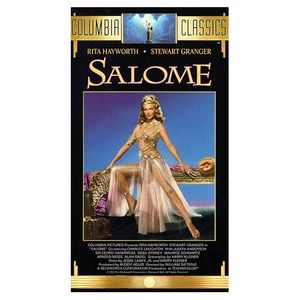Salomé: Difference between revisions
m (Text replacement - " evil" to " evil") |
m (Text replacement - "Ben-Hur" to "''Ben Hur''") |
||
| Line 11: | Line 11: | ||
== In film == | == In film == | ||
{{from imdb}} | {{from imdb}} | ||
Religious epics from the 50 run the gamut from well-made and reverential films like "The Robe" and Academy Award-winning champ "Ben | Religious epics from the 50 run the gamut from well-made and reverential films like "The Robe" and Academy Award-winning champ "''Ben Hur''" to the camp entertainment of "The Ten Commandments" to downright awful productions like "The Silver Chalice"(Jack Palance at his overacting best). | ||
Well, "Salome" falls somewhere in the middle. It is both historically inaccurate and captivatingly seductive while attempting to be as pious as audiences of the decade demanded in their Bible-based dramas. | Well, "Salome" falls somewhere in the middle. It is both historically inaccurate and captivatingly seductive while attempting to be as pious as audiences of the decade demanded in their Bible-based dramas. | ||
Revision as of 10:33, 28 June 2022
http://www.victorianweb.org/gender/salome.html website Updated: 2001 |
In Christian mythology, Salome was the daughter of Herodias and stepdaughter of Herod Antipas, ruler of Galilee in Palestine. Her infamy comes from causing St. John the Baptist's execution. The saint had condemned the marriage of Herodias and Herod Antipas, as Herodias was the divorced wife of Antipas's half-brother Philip. Incensed, Herod imprisoned John but feared to have the well-known prophet killed. Herodias, however, was not mollified by John's incarceration and pressed her daughter Salome to "seduce" her stepfather Herod with a dance, making him promise to give her whatever she wished. At her mother's behest, Salome thus asked for the head of John the Baptist on a platter. Unwillingly, Herod did her bidding, and Salome brought the platter to her mother.
The popular story made for excellent subject matter in the artwork of Gustave Moreau and Aubrey Beardsley, and revisions of Salome appear in the literature. Oscar Wilde wrote his one-act play Salomé, originally written in French, to shock audiences with its spectacle of perverse passions. The censor stopped rehearsals because of its use of biblical characters, though the play did go on to be published in 1893 with an English translation following in 1894 including the famous illustrations of Beardsley.
Wilde's play became the source and inspiration for Richard Strauss's one-act opera also named Salomé, first produced in 1905. Herod's lust for Salome is emphasized, which Salome uses to gain her wishes by performing the famous "Dance of the Seven Veils." Salome, in turn, desires to have John the Baptist - a new interpretation of the original myth. In the end, the only way Salome may have any part of John, quite literally, meant that she must demand his head be given to her. Salome fulfills her passion by kissing the dead lips of John's decapitated head, who had previously rejected her. This new and more familiar version of Salome depicts her as a seductress of her stepfather and a murderer of a saint, thereby becoming a symbol of the erotic and dangerous woman, the femme fatale.
In film
Religious epics from the 50 run the gamut from well-made and reverential films like "The Robe" and Academy Award-winning champ "Ben Hur" to the camp entertainment of "The Ten Commandments" to downright awful productions like "The Silver Chalice"(Jack Palance at his overacting best).
Well, "Salome" falls somewhere in the middle. It is both historically inaccurate and captivatingly seductive while attempting to be as pious as audiences of the decade demanded in their Bible-based dramas.
This Rita Hayworth vehicle does well as a showcase for the actress/dancer whose natural beauty was enhanced in glorious Technicolor. As the daughter of King Herod, Hayworth's Salome is a study in contrasts: one that is torn between her duty to the monarchy and to the romantic advances of Christian-convert Stewart Granger.
Charles Laughton is somewhat hammy as Herod, but all great actors have their occasional over-the-top roles. Dame Judith Anderson adds another evil matriarch to her long line of "bad girls" as Heroditus, wife of Herod and the chief catalyst behind the beheading of John the Baptist (Alan Badel).
Hey, the flick ain't Shakespeare, but it does hold the interest especially Hayworth's "Dance of the Seven Veils".
Chat rooms • What links here • Copyright info • Contact information • Category:Root
